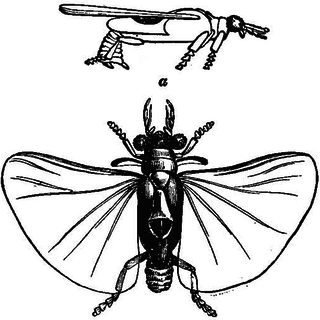
The Strepsiptera are an endopterygote order of insects with nine extant families that include about 600 described species. They are endoparasites in other insects, such as bees, wasps, leafhoppers, silverfish, and cockroaches. Females of most species never emerge from the host after entering its body, finally dying inside it. The early-stage larvae do emerge because they must find an unoccupied living host, and the short-lived males must emerge to seek a receptive female in her host. They are believed to be most closely related to beetles, from which they diverged 300–350 million years ago, but do not appear in the fossil record until the Mid-Cretaceous around 100 million years ago.

The Odonata are an order of flying insects that includes the dragonflies and damselflies. Like most other flying insects, they evolved in the early Mesozoic era. Their prototypes, the giant dragonflies of the Carboniferous, 325 mya, are no longer placed in the Odonata but included in the Protodonata or Meganisoptera.

The insect order Zoraptera, commonly known as angel insects, contains a single family, the Zorotypidae, which in turn contains one extant genus Zorotypus with 44 extant species and 11 species known from fossils. They are small and soft bodied insects with two forms: winged with wings sheddable as in termites, dark and with eyes (compound) and ocelli (simple); or wingless, pale and without eyes or ocelli. They have a characteristic nine-segmented beaded (moniliform) antenna. They have mouthparts adapted for chewing and are mostly found under bark, in dry wood or in leaf litter.
Michael S. Engel, FLS, FRES is an American paleontologist and entomologist, notable for contributions to insect evolutionary biology and classification. In connection with his studies he has undertaken field expeditions in Central Asia, Asia Minor, the Levant, Arabia, eastern Africa, the high Arctic, and South and North America, and has published more than 760 papers in scientific journals and over 800 new living and fossil species. Some of Engel's research images were included in exhibitions on the aesthetic value of scientific imagery. Engel is the author of Innumerable Insects and co-author of Evolution of the Insects.

Mantispidae, known commonly as mantidflies, mantispids, mantid lacewings, mantisflies or mantis-flies, is a family of small to moderate-sized insects in the order Neuroptera. There are many genera with around 400 species worldwide, especially in the tropics and subtropics. Only 5 species of Mantispa occur in Europe.

Stylopidae is a family of twisted-winged insects in the order Strepsiptera. There are about 15 genera and more than 330 described species in Stylopidae.

Myrmecolacidae is an insect family of the order Strepsiptera. There are four genera and about 98 species in this family. Like all strepsipterans, they have a parasitic mode of development with males parasitizing ants while the females develop inside Orthoptera. The sexes differ greatly in morphology making it very difficult to match females to the better catalogued museum specimens of males.

Xylomyidae is a family of flies known commonly as the wood soldier flies. They are xylophagous and are associated with dead or dying wood.

Tetrigidae is an ancient family in the order Orthoptera, which also includes similar families such as crickets, grasshoppers, and their allies. Species within the Tetrigidae are variously called groundhoppers, pygmy grasshoppers, pygmy devils or "grouse locusts".

The Berothidae are a family of winged insects of the order Neuroptera. They are known commonly as the beaded lacewings. The family was first named by Anton Handlirsch in 1906.

Psychopsidae is a family of winged insects of the order Neuroptera. They are commonly called silky lacewings.

Xenos is a genus of insects belonging to the family Stylopidae. The word derives from the Greek word for strange. A species of the genus is Xenos vesparum, first described by Pietro Rossi in 1793. The females are permanent entomophagous endoparasites of Polistes paper wasps. They dwell their whole lives in the abdomens of wasps.
Epicaerus is a genus of broad-nosed weevils in the family Curculionidae. There are at least 11 described species in Epicaerus.

Lygistorrhinidae is a family of long-beaked fungus gnats in the order Diptera. There are about 7 genera and at least 30 described species in Lygistorrhinidae.

Caenocholax fenyesi is a species of twisted-winged parasitic insects in the order Strepsiptera and family Myrmecolacidae. It has a sporadic distribution throughout North America, Central America, and South America. Chaenochlax brasiliensis is the only other named species in the genus.
Microphorites is an extinct genus of flies in the family Dolichopodidae.
This list of fossil insects described in 2016 is a list of new taxa that were described during the year 2016, as well as other significant discoveries and events related to insect paleontology that are scheduled to occur in the year 2016.
Burmese amber is fossil resin dating to the early Late Cretaceous Cenomanian age recovered from deposits in the Hukawng Valley of northern Myanmar. It is known for being one of the most diverse Cretaceous age amber paleobiotas, containing rich arthropod fossils, along with uncommon vertebrate fossils and even rare marine inclusions. A mostly complete list of all taxa described up until 2018 can be found in Ross 2018; its supplement Ross 2019b covers most of 2019.












